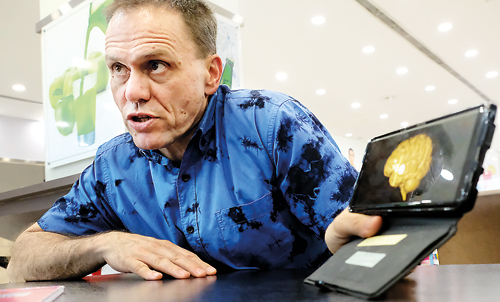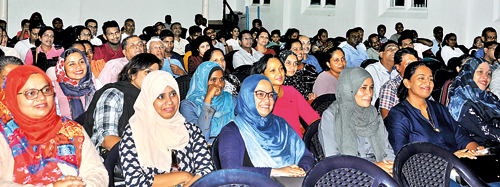Hooked on ‘digital cocaine’?

All in the brain: Brad Huddleston in Colombo. Pix by Amila Gamage
Cocaine. It strikes fear in most hearts. Unfortunately, there is a ‘drug’ equally to be feared that is invading our homes, our workplaces and is with us almost everywhere we go. You might even be reading this now with its aid.
That new drug is technology. In Sri Lanka last month, American author and teacher Brad Huddleston warned that Digital Addiction is becoming more and more common and can quite insidiously spiral out of control. Functional Magnetic Resonance Imaging (FMRI) scans of a person addicted to cocaine and someone digitally addicted are practically identical, he points out.
But life without technology Brad agrees, is almost impossible. With a degree in computer science, he himself was addicted – he had a workspace at home with the latest computers etc. (and still does), he would stay up late creating educational programmes etc. for work until it came to a point where he experienced burnout. He needed to detox from technology, and then learnt to re-integrate technology into his life in a positive way.
Now, he spends six months of the year travelling around the world speaking about digital addiction – the topic of his second and latest book, ‘Digital Cocaine’. In Sri Lanka last month, he addressed many school audiences and concerned adults.

Taking the message: The audience at one of Brad’s Colombo workshops
The biggest problem with ‘digital cocaine’ as he calls it is that people are unwilling to admit that they even have a problem. “Digital Addiction is a very real addiction. We used to laugh it off and use the word addiction in a metaphorical sense but thanks to neuroscience we now know that it is a literal, chemical addiction analogous to two drugs – cocaine and heroin and in the case of pornography, when you see the brain scans, it’s as if the two have been mixed. So the brain scans for example, of a heroin addict and a porn addict when compared side by side – the porn addict is worse – it’s more difficult to treat a porn addict than a heroin addict,” explains Brad.
The science behind digital addiction is similar to that of other addictions such as alcohol abuse. First you start small – one video game, a little bit of Netflix etc. Then you feel like you want more – ‘just five more minutes of Netflix’ (which is never just the five minutes you think you want) and soon you are hooked. What happens in your brain is that your ‘pleasure centre’ is activated and releases dopamine, making you feel happy. As things progress, your brain gets accustomed to the dopamine and you need more digital activity and very soon, you find yourself up all night watching Netflix, gaming or playing Candy Crush etc. At its worst, people who are digitally addicted will not sleep or function normally, the addiction taking over their lives the same way most other addictions do.
A 3-6 week detox is best for those with severe digital addiction – the most effective way is to quit cold turkey, he says, explaining that when addicted, the brain’s impulse control doesn’t work, which is why there should be no technology used during that period and then be carefully reintegrated in measured amounts. “What I tell people regarding picking a 4-6 week period to detox is that either you do it or your brain will do you a favour and do it for you and it rarely does it at a convenient time. When your brain does it it will be really inconvenient and you might be on the couch for four weeks with panic attacks – mine was,” he states firmly.
“When I see someone glued to their phone, all I feel is compassion,” he says, adding that he hopes that by spreading his message on digital addiction, he will be able to help as many people as he can.
See https://bradhuddleston.com/ for more information.
| Beat the menace | |
| 1) Remove all technology from bedrooms 2) Sleep the recommended amount for your age (generally 8 hours but differs according to age) 3) Limit the use of ALL digital devices – using devices for educational purposes is just as addictive as everything else – the brain doesn’t distinguish content 4) Quit video games as they are too stimulating 5) Turn off all push notifications 6) Exercise daily or at least regularly – it prevents depression (depressed people get addicted to technology more easily) 7) Monotask – the brain can only handle one thing at a time 9) Stop screen time three hours before bed. The chemicals released from the screen in the brain are stimulating and take 1.5-3 hours to leave the brain before you can sleep deeply. 10) Engage in actual phone conversations rather than texts or Whatsapp messages Preventing digital addiction in children 1) Don’t introduce technology to your children till age 12 2) Allow only technology which is productive after age 12 and limit it strictly 3) Buy your kids ‘dumb phones’ which aren’t connected to the internet etc. |


